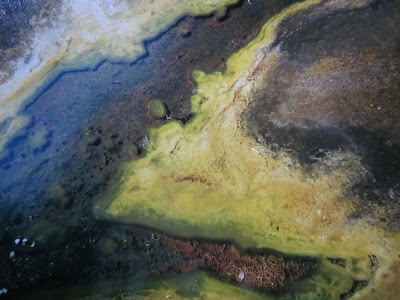When I was looking for the muslin the other day I uncovered this:
"What the heck is that?" you ask. Appropriate question. A few years ago I took a three-day art quilting design class with Ann Johnston. It was a good class and I learned a few quilting techniques, and had some good exercises on the value of line and shape in fabric design. She asked us to bring some of our own favorite photos to use as inspiration. This was one of the ones I chose:
"What the heck is that?" you ask, again. Apologies for the photo quality, it was taken in the BDC (before digital camera) era with a really cheap 35mm point and shoot. Remember how film used to be expensive and you'd only take one or two shots of something, rather than 30 and pick the best? Anyway I digress. This is algae growing near the edge of a Yellowstone hot spring. You better bet that next time I get back to Yellowstone I'm taking a couple extra SD cards for a few thousand photos. Anyway...
Our project on the last day of the class was to use what we'd learned in the class to make a small quilt based on one of our photos. I chose to simplify the bright colors of the algae and try to capture the movement of the water.
I actually still really like this quilt. When I got it home I continued the quilting lines within the central area and started quilting the lighter green.
But I kept breaking threads and needles, no matter what I tried. That is when I realized something very, very important. This quilt was made using reverse applique of several layers of fabric. I did not trim away the excess underneath layers, the other people in the class said that probably wasn't necessary and the extra layers would create a firmness that would be an interesting effect in the finished product. What I failed to realize was that I, as the youngest and poorest member of the class, was using an entry-level basic Kenmore sewing machine, everyone else was using fancy Berninas and whatnot. And when free-motion quilting, my basic Kenmore can't handle more than three or four layers (fabric, batting, fabric) in the quilt sandwich.
So lessons learned:
1) know your machine
2) think about the advice of others, if it will really work for you, and
3) if I'm serious about this quilting thing, invest in a better machine.
But today I'm still using the basic Kenmore. It does still work well for most general applications. And because of space restrictions I'm not going to be doing large quilts anyway so now I just have to be careful about how I construct the smaller things, most of my work is done by hand anyway.
So that's the end of the tale, for now, at least. I still rather like this unfinished little beast, and if I ever do upgrade my machine, I think finishing this little quilt will probably be how I learn the new machine's quirks.





No comments:
Post a Comment